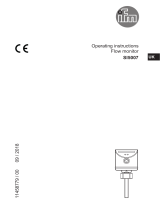
2
Contents
1 Preliminary note ...................................................................................................4
1.1 Symbols used ................................................................................................4
2 Safety instructions ...............................................................................................4
3 Functions and features ........................................................................................5
3.1 Applications ...................................................................................................5
4 Function ...............................................................................................................6
4.1 Operating modes ...........................................................................................6
4.1.1 2-wire operation .................................................................................... 6
4.1.2 3-wire operation .................................................................................... 6
4.2 Switching function (only for 3-wire operation) ................................................7
4.3 Analogue function ..........................................................................................7
4.4 Customer-specific calibration ........................................................................8
5 Installation..........................................................................................................10
5.1 Units with G1 / Aseptoflex Vario process connection...................................10
5.2 Use in hygienic areas to 3-A ........................................................................ 12
5.3 Use in hygienic areas to EHEDG ................................................................12
5.4 Ventilation diaphragm ..................................................................................13
5.4.1 Function ventilation diaphragm ...........................................................13
5.4.2 Orientation ..........................................................................................14
5.5 Filter cover ...................................................................................................14
6 Electrical connection ..........................................................................................16
6.1 Connection for 2-wire operation ..................................................................16
6.2 Connection for 3-wire operation ..................................................................16
7 Operating and display elements ........................................................................17
8 Menu ..................................................................................................................18
8.1 Menu structure: main menu .........................................................................18
8.2 Explanation of the main menu .....................................................................19
8.3 Menu structure: level 2 (extended functions) ...............................................20
8.4 Explanation of menu level 2 ........................................................................21
8.5 Menu structure: level 3 (simulation) .............................................................22
8.6 Explanation of menu level 3 ........................................................................23
9 Parameter setting ..............................................................................................24
9.1 Parameter setting in general .......................................................................24
9.2 Configure display (optional) ......................................................................... 26























